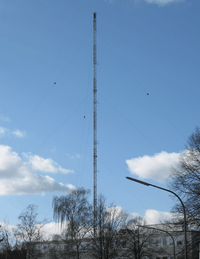Measurement tower

A measurement tower is a free standing tower or a removed mast, which carries measuring instruments with meteorological instruments such as thermometers and wind velocity measurers. Measuring towers are an essential component of rocket launching sites, since one must know exact wind conditions for an execution of a rocket start. Also in the proximity of some nuclear power stations (as in Grafenrheinfeld, Germany) there are measuring towers. Beside measurement towers, which are equipped with meteorological measuring instruments, there are also measuring towers for measuring the radiation pattern of antennas. Such towers are frequently implemented as metal-free timber constructions for the avoidance of disturbance of the radiation pattern, as the measuring towers of the antenna measuring position in bridge.[1]
Examples
Meteorology
- Obninsk Meteorological tower, Obninsk, Russia
- Zotino Tall Tower Observation Facility, Zotino, Russia
- Košetice Meteoroligal Tower, Košetice, Czech
- KNMI-mast Cabauw, Cabauw, Netherlands
- Meteorological tower of Forschungszentrum Karlsruhe, Karlsruhe, Germany
- Rödeser Berg Meteorological Mast, Wolfshagen, Germany
- KFU-Tower Gundremmingen, Gundremmingen, Germany
- KFU-Mast Grafenrheinfeld, Grafenrheinfeld, Germany
- Mast of Richard Assmann Observatory, Falkenberg, Germany
- Mast of Asbach near Obrigheim, Germany ( dismantled)
- Mast of Obrigheim Nuclear Power Plant, Obrigheim, Germany
- Mast of Dukovany Nuclear Power Station
- Oskar-von-Miller-Tower, Garching, Germany
Other measurement towers
- Aerial test facility Brück, Brück, Germany
- BREN Tower, Nevada Test Side, USA
Wind farm development
Before developers construct a wind farm, they first measure the wind resource on a prospective site by erecting temporary measurement towers. Typically these mount anemometers at a range of heights up to the hub height of the proposed wind turbines, and they log the wind speed data at frequent intervals (e.g. every ten minutes)[2] for at least one year and preferably two or more. The data allow the developer to determine if the site is economically viable for a wind farm, and to choose wind turbines optimized for the local wind speed distribution.
References
- ↑ Luis Santos Pereira, John W. Gowing (1998). "Water and the Environment: Innovation Issues in Irrigation and Drainage". International Commission on Irrigation and Drainage Portuguese National Committee (Taylor & Francis). ISBN 0-419-23710-0.
- ↑ "Anemometer Loan Programs". Wind Powering America, NREL, USDOE. 2009-09-01. Retrieved 2010-05-04.